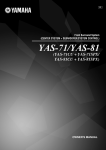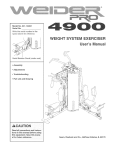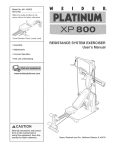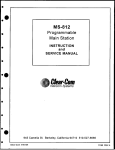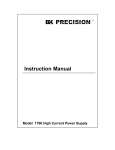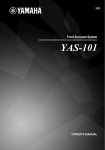Download Yamaha YHT-380 Owner`s manual
Transcript
@
HomeTheaterPackage
(SubwooferIntegratedReceiver+ Speaker)
YHT-S300
(SR-300
+ NS-B380)
Owner's Manual
1 To assure the finest performance, please read this
manual carefully. Keep it in a safe place for future
reference.
2
3
4
5
Install this unit in a well ventilated, cool, dry, clean
place - away from direct sunlight, heat sources,
vibration, dust, moisture, and/or cold. For proper
ventilation, allow the following minimum clearances.
Top: 5 cm (2 in)
Rear: 5 cm (2 in)
Sides: 5 cm (2 in)
Locate this unit away from other electrical appliances,
motors, or transformers to avoid humming sounds.
Do not expose this unit to sudden temperature changes
from cold to hot, and do not locate this unit in an
environment with high humidity (i.e. a room with a
humidifier) to prevent condensation inside this unit,
which may cause an electrical shock, fire, damage to
this unit, and/or personal injury.
Avoid installing this unit where foreign objects may fall
onto this unit and/or this unit may be exposed to liquid
dripping or splashing. On the top of this unit, do not
place:
standby mode, and disconnect the power supply cable
from the wall outlet.
18 Condensation will form when the surrounding
temperature changes suddenly. Disconnect the power
supply cable from the outlet, then leave the unit alone.
19 Install this unit near the wall outlet and where the AC
power plug can be reached easily.
20 The batteries shall not be exposed to excessive heat such
as sunshine, fire or like.
21 Secure placement or installation is the owner's
responsibility. Yamaha shall not be liable for any
accident caused by improper placement or installation of
speakers.
WARNING
TO REDUCE
SHOCK, DO NOT EXPOSE
OR MOISTURE.
6
7
8
9
10
11
12
13
14
15
(i.e. candles), as they may cause fire, damage to
personal injury.
liquid ill them, as they may fall and liquid may
shock to the user and/or damage to this unit.
Do not cover this unit with a newspaper, tablecloth,
curtain, etc. in order not to obstruct heat radiation. If the
temperature inside this unit rises, it may cause fire,
damage to this unit, and/or personal injury.
Do not plug in this unit to a wall outlet until all
connections are complete.
Do not operate this unit upside-down. It may overheat,
possibly causing damage.
Do not use force on switches, knobs and/or cords.
When disconnecting the power cable from the wall
outlet, grasp the plug; do not pull the cable.
Do not clean this unit with chemical solvents; this might
damage the finish. Use a clean, dry cloth.
Only voltage specified on this unit must be used. Using
this unit with a higher voltage than specified is
dangerous and may cause fire, damage to this unit, and/
or personal injury. Yamaha will not be held responsible
for any damage resulting from use of this unit with a
voltage other than specified.
To prevent damage by lightning, keep the power cable
and outdoor antennas disconnected from a wall outlet or
the unit during a lightning storm.
Do not attempt to modify or fix this unit. Contact
qualified Yamaha service personnel when any service is
needed. The cabinet should never be opened for any
reasons.
When not planning to use this unit for long periods of
time (i.e. vacation), disconnect the AC power plug from
the wall outlet.
16 Be sure to read the "Troubleshooting" section on
common operating errors before concluding that this
unit is faulty.
17 Before moving this unit, press @ to set this unit in
2 En
THIS UNIT TO RAIN
As long as this unit is connected to the AC wall
outlet, it is not disconnected from the AC power
source even if you turn off this unit by _. In this
state, this unit is designed to consume a very small
quantity of power.
Other components, as they may cause damage and/or discoloration
on the surface of this unit.
Burning objects
this unit, and/or
Contaiuers with
cause electrical
THE RISK OF FIRE OR ELECTRIC
•
For U.K. customers
If the socket outlets in the home are not suitable
for
the plug supplied with this appliance, it should be cut
off and an appropriate 3 pin plug fitted. For details,
refer to the instructions described below.
The plug severed from the mains lead must be destroyed, as
a plug with bared flexible cord is hazardous if engaged in a
live socket outlet.
•
Special Instructions
for U.K. Model
IMPORTANT
THE WIRES IN THE MAINS LEAD ARE
COLOURED IN ACCORDANCE
WITH THE
FOLLOWING
CODE:
Blue: NEUTRAL
Brown: LIVE
As the colours of the wires in the mains lead of this
apparatus may not correspond with the coloured
markings identifying the terminals in your plug,
proceed as follows:
The wire which is coloured BLUE must be
connected to the terminal which is marked with the
letter N or coloured BLACK. The wire which is
coloured BROWN must be connected to the
terminal which is marked with the letter L or
coloured RED.
Making sure that neither core is connected
earth terminal of the three pin plug.
to the
mNTRODUCT|ON
Getting
started
USEFUL
....................................................
Supplied parts ........................................................
Controls and functions ..........................................
Placing .................................................................
Placing the speakers ..............................................
Connection
........................................................
Overview .............................................................
Connecting a TV .................................................
Connecting
Blu-ray
disc player
4
4
5
8
8
10
10
11
or
set-top box .......................................................
11
m_
OPERATmON
Setup menu .......................................................
Overview
18
.............................................................
18
Basic procedure ...................................................
Adjusting the volume balance during
playback ...........................................................
Adjusting high/low frequency sound
(tone control) ....................................................
18
Adjusting the audio delay ....................................
Setting the audio output ......................................
Switching on/off the HDMI TM control
function ............................................................
19
19
19
19
19
Changing the brightness of the front panel
display ..............................................................
Changing the setting of the speaker type ............
Setting the distance between the speakers ..........
Using the HDMr rM control function ...................
20
20
20
21
BASmC OPERATmON
Basic playback
operation
.................................
12
Enjoying sound modes .....................................
Surround mode ....................................................
Stereo mode ........................................................
UniVolume TM ......................................................
13
13
13
13
Listening
14
to FM broadcasts
.............................
Basic tuning operation ........................................
Editing the preset FM station ..............................
Using optional
equipment
................................
ADDITIONAL
Additional
mNFORMATION
information
....................................
22
Troubleshooting ..................................................
Glossary ...............................................................
Specifications ......................................................
Available signal information ...............................
22
25
27
28
14
14
16
Connecting dock .................................................
16
Using iPod rM.......................................................
16
Using Bluetooth TM components .......................... 17
• About this manual
• In this manual, operations that can be performed using either the front panel buttons or the remote control
explained using the remote control.
• -",6"-indicates a tip for your operation. Notes contain important information about safety and operating
instructions.
are
• This manual is produced prior to production. Design and specifications
are subject to change in part as a result
of improvements,
etc. In case of differences between the manual and the product, the product has priority.
3 En
INTRODUCTION
This product consists of the following
following items.
items. Before making connections,
make sure you have received
all of the
• Units
Subwoofer Integrated Receiver (SR-300)
":6oh
\-.-
-//
Speakers (NS-B380)
_
• Accessories
Remote control
Speaker cable (3 m x 2)
J
Stand x 2
(for speaker)
Indoor FM antenna
(Asia model)
Battery x 2 (AAA, R03, UM4)
Screw x 2
(for stand)
Quick Reference
Guide
(Europe and Russia
models)
CD-ROM
(Owner's Manual)
• Installing the batteries
• If the effective operation distance of the remote control decreases considerably,
replace
the batteries with two new ones as soon as possible.
• Do not use an old battery together with new one.
• Do not use different types of batteries (for example, alkaline and manganese) together.
Their performance
will vary, even if they are similar in shape.
• If the batteries run out, immediately
remove them from the remote control to prevent an
explosion or acid leak.
• Dispose of batteries according to regional regulations.
• If a battery starts leaking, dispose of it immediately.
Be careful not to let leaking battery
acid come into contact with your skin or clothing. Before inserting new batteries, wipe
the compartment
clean.
4 En
• Front panel of the subwoofer
integrated receiver
@ INPUT
Turns on the system, or sets it to standby
(_
P. 12)
mode.
Selects an input source you want to listen to.
(_
P. 12)
@ VOLUME
Controls the volume
A small amount of electricity is consumed to receive
the infrared signal from the remote control even when
the system is in standby mode.
@ STATUS indicator
Lights up to show the system condition. (_
-/+
@ Remote
control
Receives infrared
(_
P. 7, 10)
P. 12)
of the system. (_
P. 12)
sensor
signals from the remote control.
@ Front panel display
Shows information about the operational
the system. (_
P. 12)
• Rear panel of the subwoofer
integrated
status of
receiver
@YAMAHA
L
r
@ Power Cable
For connecting an AC wall outlet. (_
@ HDMI IN @- @/HDMI
@ ANALOG
P. 10)
OUT
• HDMI IN @ - @ for connecting HDMI
compatible external components. (_
P. 11)
• HDMI OUT for connecting an HDMI
compatible TV. (_
P. 11)
@ DIGITAL
IN jack
For connecting
(_
P. 11)
optical digital cable to the TV.
INPUT jack
For connecting analog audio cable to external
components. (_
P. 10)
@ DOCK
terminal
For connecting an optional Yamaha iPod universal
dock (such as YDS-11, sold separately) or
Bluetooth wireless audio receiver (such as YBA10, sold separately). (_
P. 16)
ANTENNA
terminal
For connecting
SPEAKERS
For connecting
supplied FM antenna.
(_
P. 10)
terminal
speakers.
(_
P. 10)
5 En
• Front panel display of the subwoofer
@ HDMI indicator
when
@ Tuner indicators
indicator
Lights up when the system is receiving
(_
P. 14)
STEREO
a station.
indicator
Lights up when the system is receiving a strong
signal from an FM stereo broadcast station in
automatic tuning mode. (_
P. 14)
AUTO
indicator
Flashes when the system is tuning station
automatically.
(_
P. 14)
MEMORY
indicator
Flashes when the system is storing a station.
(_
P. 14, 15)
EMPTY
indicator
Lights up when the storing preset number is empty.
(_
P. 15)
PS/PTY/RT/CT
Russia
indicator
models
Lights up according
System information.
@ Decoder
(Europe
and
only)
to the available
(_
P. 15)
Radio Data
indicators
The respective indicator lights up when any of the
decoders of the system is activated.
6 En
receiver
@ DOCK indicator
Lights up during normal communication
HDMI is selected as an input source.
TUNED
integrated
• Lights up when the system is receiving a signal
from an iPod stationed in the Yamaha iPod
universal dock (such as YDS-11, sold
separately) connected to the DOCK terminal of
the subwoofer integrated receiver. (_
P. 16)
• Lights up while the Yamaha Bluetooth wireless
audio receiver (such as YBA-10, sold
separately) is connected to the Bluetooth
component. (_
P. 17)
• Flashes while the connected Yamaha Bluetooth
wireless
audio receiver
(such as YBA-10,
sold
separately) and the Bluetooth component are
pairing (_
P. 17) or while the Yamaha
Bluetooth wireless audio receiver is searching
for the Bluetooth component. (_
P. 17)
@ VOLUME
indicator
• Indicates the current volume level.
• Flashes while the mute function is activated.
(_
P. 12)
@ Multi information
display
Shows the selected input source, current sound
mode and other information.
@ ENHANCER
indicator
Lights up when compressed music enhancer
function is activated. (_
P. 16)
@ UNIVOLUME
indicator
Lights up when UniVolume
(_
P. 13)
mode is selected.
• Remote control
Infrared signal
transmitter
Input buttons
Select an input source you want to listen to.
(_
P. 12)
@ MEMORY,
TUNING
_/_,
PRESET
,,,,Iv,
INFO
Control an FM tuner. (_
P. 14)
@ OPTION
Enters OPTION menu when operating FM
function or using Bluetooth component. (_
17)
@ /_ (MENU)
/ _(P4Pg) / [_(1_t)
/ _(_
P. 14,
||)
/
Q(Center)
• Change the setting.
• Control an iPod. (_
P. 16)
• / V: Control the wheel of iPod.
@ RETURN
Returns to the previous menu or cancels preset
registration/pairing
operation.
@ SUBWOOFER
(+/-)
Adjust the volume
(_
P. 19)
@ SURROUND
MODE
Selects the surround
@ STEREO
balance of subwoofer.
mode. (_
P. 13)
MODE
Turns extended
(_
P. 13)
stereo mode on and off alternately.
@ UNIVOLUME
Turns UniVolume
@ VOLUME
mode on and off. (_
P. 13)
(+/-)/MUTE
Control the volume
of the system. (_
P. 12)
@ SETUP
Enters the setup menu. (_
P. 18)
@ 4)
Turns on the system, or sets it to standby
(_
P. 12)
mode.
7 En
PREPARATION
To enjoy quality sound thoroughly, place this system in the appropriate positions,
properly. The following illustrations are the setting images of this system.
Example
1 : Placing the speakers
on the rack
Example
and install the components
2 : Mounting
the speakers
on the wall
@ Subwoofer integrated receiver (SR-300)
@ Speakers (NS-B380)
• Do not place this system on/under any other components
such as Blu-ray disc player m a pile. The vibration of this system
may cause system failure, etc. in other components.
• Keep enough ventilation space on the front, rear, and bottom side (that attached legs) of this system. Do not place this
system on a thick carpet etc.
• If the picture on your CRT TV screen becomes blurred or distorted, we recommend
moving the system away from your TV.
• Low frequency sound produced by the subwoofer integrated receiver may be heard differently depending on the listening
position and subwoofer location. To enjoy desired sounds, try changing the location of the subwoofer integrated receiver.
• Depending on your installation environment,
connections to external components can be done before installing this system.
We recommend that you temporarily place and arrange all components in order to decide which procedure is best done first.
• Set the distance between the speakers to increase surround effect. (_
P. 20)
You can place the speakers on a rack or attach it to a wall. Select an installation
method that suits your environment.
• Placing the speakers using the stands
You can place the speakers
in an upright position or a horizontal
position.
When placing the speakers in an upright
position
When placing the speakers in a horizontal
position
Place the speaker on the stand vertically, and then secure
it with the screw as shown in the illustration
below.
Place the speaker on the stand horizontally,
8 En
secure it with the screw
below.
as shown
and then
in the illustration
• Attaching the speakers to a wall
Installing the speakers using the keyholes
You can attach the speakers to a wall using
commercially
available screws (#8, Diameter:
mm (1/4" to 3/8")).
7 to 9
When installing the speakers on a wall, all
installation work must be performed by a
qualified contractor or dealer. The customer
must never attempt to perform this installation
work. Improper or inadequate installation could
cause the speakers to fall, resulting in personal
injury.
When placing the speakers
remove the stands.
Install screws
on a wall,
on a wall as shown
in the
• Do not attach the speakers to a wall that is made of weak
materials such as plaster or veneered woods. Doing so
may cause the speakers to fall.
• Use commercially available screws that can support the
weight of the installation.
• Make sure you use specified screws to attach the speakers.
Using clamps other than specified screws, such as short
screws, nails, or two-sided tape, may cause the speakers to
fall.
• When connecting the speakers, fix the speaker cables in
place where they will not become loose. If your foot or
hand accidentally gets caught on a loose speaker cable, the
speakers may fall.
• After attaching the speakers, check that the speakers are
fixed securely. Yamaha will bear no responsibility for any
accidents caused by improper installations.
illustration.
The distance
mm (5-7/8")
between
150
for both sides
Hang the speakers
the keyholes
the screws:
on the screws
using
on the back of the speakers.
mm
Minimum
20 mm
I_-=d
9 En
• Do not connect the power cable until all connections are completed.
• Do not use excessive force when inserting the cable plug. Doing so may damage the cable plug and/
or terminal.
Follow the procedure
below to connect the subwoofer
integrated
receiver
and the external components.
Indoor FM antenna (supplied)
Twist and pull off the
insulation tube on the
lead wire.
Insert to the terminal of the
correct polarity--positive
(+) to positive (+), and
negative (-) to negative (-).
If the radio wave reception is weak in your area
or you want to improve the radio wave reception,
we recommend that you use an outdoor antenna.
For details, consult your nearest authorized
Yamaha dealer or Service Center.
White
Gray
See "Using optional
equipment". (_ P. 16)
_3
VCR, etc.
Front Right
Speaker
Speaker
To AC wall outlet
After you have made all connections, connect the
power cable of the subwoofer integrated receiver.
See "Connecting Blu-ray disc player or set-top _
box". (_
P. 11)
See "Connecting
Connect
receiver.
lO
En
your speaker
(_
P. 20)
as the center speaker
a TV". (_
P. 11) ...........................................................................................................
of this system to the SPEAKERS
© terminal
of the subwoofer
integrated
If a DVD player, etc., is connected to one of the HDMI IN jacks, connect your TV or video monitor (projector,
etc.) to the HDMI OUT jack of the subwoofer integrated receiver.
To output the sound of a TV from this system, you can select optical digital input and connect to digital output
jack.
iiiiiiiiiiiiiiiiiiiiiiiiiiiiiiiiiiiiiiiiiiiiiiiiiiiiiiiiiiiiiiiiiiiiiiiiiiiiiiiiiiiii
_ullEi
TV
,,,,-_: Signal flow
For analog connection, you need to connect an audio cable to the analog input terminal.
You can connect external components
three jacks are identical.
with HDMI output. You can select from HDMI IN @, @, or @. These
Blu-ray disc player or
set-top box
11
BASICOPERATION
Once you have finished all cable connections
basic playback operation.
and remote control
2
operation,
follow the procedure
below to start
Press one of the input buttons
to select
an input source.
3
Start playback
on the selected
external
component.
For information on the external component,
to the instruction manual for the product.
4
Press VOLUME
level.
refer
+/- to adjust the volume
To turn off the volume temporarily, press MUTE.
While the mute function is activated, the VOLUME
indicator flashes. To resume the volume, press MUTE
again or press VOLUME +/-.
When sound of HDMI is output from the TV, the
volume level does not change if you press VOLUME
+/-.
Press
_.
This system is turned on and the STATUS
indicator lights green.
Press _ again to set the system to
standby mode.
When the "HDMI CONTROL" is set to "ON", the
STATUS indicator lights red. When the "HDMI
CONTROL" is set to "OFF", the STATUS indicator
turns off. (_ P. 19)
This system has the auto-sleep function, which will
automatically
switch the system to turn off if the
system is left turned on for 24 hours without any
operation being performed.
• Using the remote control
Use the remote control within 6 m (20') of the
subwoofer integrated receiver and point it toward the
remote control sensor.
• Be careful not to spill liquid on the remote control.
• Be careful not to drop the remote control.
• Do not leave the remote control in a place that is:
- hot or humid, such as near a heater or in a bathroom
- extremely cold
- dusty
12 En
_a02._
a_2_0_ Within 6 m (20')
STEREO
SURROUND
MODE
UNIVOLUME
You can enioy a realistic sound effect using Yamaha's
exclusive AIR SURROUND
XTREME.
An extended
Press SURROUND
surround mode.
Press STEREO
stereo mode.
MODE
MODE
to set
Press SURROUND MODE repeatedly until desired
mode appears in the front panel display.
sound is achieved
for a 2 channel
source
such as a CD player.
MODE
to enter extended
Each time you press STEREO
MODE,
the function
is
turned on (EXTENDED
STEREO)
and off (STEREO)
alternately.
Surround
MOVIE
mode descriptions
This mode is useful when you enjoy
movie contents on media such as
"STEREO":
"EXTENDED
image.
Reproduces
the sound without
STEREO":
Reproduces
any effect.
a wider stereo
Blu-ray disc, etc.
MUSIC
This mode is useful when you listen to
music contents on media such as
Blu-ray disc, etc.
SPORTS
This mode is useful when you enjoy
sports programs or TV news.
GAME
This mode is useful when you enjoy
video games.
The system automatically
memorizes the settings assigned
to each input source. When you select another input, the
system automatically
recalls the last settings for the selected
input.
• The default setting is "EXTENDED
STEREO".
• The system memorizes the settings assigned to each input
source.
While watching
TV, use this function
when you feel
uncomfortable
with the difference
in volume
between
channels, TV programs,
and commercials
volume at an even level.
to keep the
Press UNIVOLUME
to activate
deactivate the function.
or
When UniVolume
is activated,
indicator
is displayed
uniformed.
• The system memorizes
UNIVOLUME
and the sound
volume
the setting assigned
of TV is
to each input
source.
• When the input source is DOCK and UniVolume
is
activated, compressed
music enhancer function is invalid
(ENHANCER
indicator disappears).
13 En
MEMORY
OPTION
• Automatic
preset
You can store up to 40 FM stations
Press
OPTION
"AUTO PRESET"
panel display.
Press
to enter
(01 to 40).
OPTION
menu.
appears firstly in the front
Press RETURN while searching automatically, automatic
preset is stopped.
Q) (Center).
Press PRESET A/V repeatedly to select a preset
number to which the first station will be stored.
After approximately
5 seconds, automatic
presetting starts from the lowest frequency and
proceeds through higher frequencies. When the
frequency is stored, the TUNED indicator lights
up.
14 En
When automatic preset tuning is completed, the front
panel display shows message "Preset Complete" for
three seconds firstly and returns to OPTION menu
secondly.
• Any stored station data existing under a preset number is
cleared when you store a new station under the same
preset number.
• If the number of received stations does not reach 40,
automatic preset tuning automatically stops after
searching for all the available stations.
• Only the station with strong signals can be stored. If the
desired station is not stored, or a station is not stored to the
desired preset number, preset the station manually.
(_w P. 15)
• Manual station preset
Use this feature to preset your desired
manually.
• Using the monaural
reception mode
station
When the signal of the desired FM station is too weak,
set the reception mode to "MONO" to increase signal
quality.
Tune into a radio station you want to
preset.
Press
Press OPTION
MEMORY.
"MANUAL PRESET" appears in the front panel
display, followed soon by the preset number to
which the station will be registered.
Display
cursor
to enter OPTION
"STEREO/MONO"
_
3
Press PRESET
number
^/v
to select the preset
(01 to 40) to which the station
will
by using the
and press Q) (Center).
Select "MONO"
By pressing down MEMORY for more than 2
seconds. The station is registered to the lowest empty
preset number or a preset number one higher than the
last preset number.
menu.
to monaural
to set the reception
mode
by using the cursor/_/_.
• Switching the information
display
Each time you press INFO,
changes as follows:
the information
display
be registered.
2:=LJ=:.P:.UUHLJ
When you select a preset number to which no
station is registered, EMPTY indicator appears on
the display. When you select a registered preset
number, a registered frequency is displayed on the
right of the preset number.
To cancel registration, press RETURN on the remote
control or leave the tuner without any operations for
about 30 seconds.
4
Press MEMORY
again to register.
Display
cursor
"CLEAR
v
to enter OPTION
PRESET"
and the frequency
You can cancel the operation
menu by pressing RETURN
3
menu.
using the
and press (_) (Center).
Preset number
display.
-'
_ .....
'
=L
"
P'¢"
appears in the
and return to OPTION
on the remote control.
"
r° P:._i:,_U_Pii_.
-'
_
.......
r"
T
¢",
Europe and Russia models only
Information
type
• SURROUND
MODE
Displays the surround
• FREQUENCY
• Clearing the preset station
Press OPTION
_p
Hi_iL,'_
Displays the frequency
• PROGRAM SERVICE
mode or stereo mode.
and preset number.
(PS)
Displays the currently received Radio Data System
program.
• PROGRAM TYPE (PTY)
Displays the type of the currently
Data System program.
• RADIO TEXT (RT)
received
Displays the information of the currently
Radio Data System program.
• CLOCK TIME (CT)
Displays
Radio
received
the current time.
Select the preset number of the registered
station you want to clear using the cursor
/_/_
and press (_) (Center).
The preset station registered to the selected preset
number is cleared. To clear the registration of
multiple preset numbers, repeat the above steps.
To end the operation, press OPTION.
15 En
This system is equipped with a DOCK terminal, which allows you to connect a Yamaha iPod universal dock (such
as YDS- 11, sold separately) or a Yamaha Bluetooth wireless audio receiver (such as YBA- 10, sold separately) to
enjoy music contents stored in your Bluetooth component (such as a portable music player or computer equipped
with Bluetooth transmitter, etc.). Connect this equipment to the DOCK terminal of the subwoofer integrated
receiver using its dedicated cable.
When DOCK is selected as the input source, compressed music enhancer function is activated automatically and enhances
your listening experience by regenerating the missing harmonics in a compressed music format such as MP3.
Yamaha iPod universal dock
(such as YDS-11, sold separately)
Yamaha Bluetooth wireless audio receiver
(such as YBA-10, sold separately)
Connect either component.
Once you have stationed
subwoofer
Supported
iPod
iPod
iPod
iPod
integrated
your iPod in the Yamaha
receiver,
iPod universal
you can enjoy playback
dock connected
to the DOCK terminal
of the
of your iPod.
iPod
(Click and Wheel including
nano
mini
touch
iPod classic)
Battery charge feature
This system charges the battery of an iPod stationed in the Yamaha iPod universal clock connected to the DOCK
terminal of the subwoofer integrated receiver, even when this system is turned off. "Charging" appears in the
front panel display.
• Some features may not be available depending on the model or the software version of your iPod.
• For a complete list of status messages that appear in the front panel display, see the "iPod" section in "Troubleshooting"
P. 24).
• Be sure to set the volume to minimum before docking or removing your iPod.
• To playback an iPod, select DOCK for input source.
• Refer to the instruction manual of your Yamaha iPod universal dock for details.
16 En
(_w
@ Select
• Pairing
About
the Yamaha
audio receiver
Bluetooth
"Pairing"
Pairing must be performed before using a Bluetooth
component with the Yamaha Bluetooth wireless
audio receiver connected to the system for the first
time or if the registered pairing data has been
deleted. "Pairing" refers to the operation of
registering a Bluetooth component for Bluetooth
communications.
To ensure security, a time limit of 8 minutes is set for the
pairing operation. Please read and fully understand all the
instructions before starting.
component,
pass key "0000"
component
you
want to pair with, and then enter pairing
mode.
Refer to the instruction
component for details.
manual of your Bluetooth
Press OPTION.
OPTION
display.
4
menu for DOCK input appears in the
Press the cursor
_
to select
"PAIRING"
and press (_) (Center).
"Searching..."
appears when the pairing starts.
While the Yamaha Bluetooth wireless audio
receiver is in pairing mode, the DOCK indicator
flashes in the front panel display.
a connection
After the pairing is completed, perform the connecting
operation on the system or on the Bluetooth
component to enable communication
between them.
The connecting operation on the system is only
available *or the most recently connected Bluetooth
component.
For details, refer to the instruction manual of Yamaha
Bluetooth wireless audio receiver.
Turn on the Bluetooth
and then enter the
on the Bluetooth
• Establishing
2
to set the input to DOCK.
wireless
list of the
component.
Press DOCK
Press DOCK
Bluetooth
in the device
Press OPTION
"CONNECT"
display.
3
to set the input to DOCK.
Press O
to enter OPTION
menu.
appears firstly in the front panel
(Center).
"Searching..."
appears
display.
When the system finds
Bluetooth component,
the front panel display
firstly in the front panel
the last connected
"BT connected" appears in
I'or 3 seconds.
• If the system cannot find the last connected Bluetooth
component,
"Not found" appears in the front panel
display.
• If you want to establish a connection with a Bluetooth
component other than the one most recently
connected to, connect from that Bluetooth
component. Refer to the instruction
Bluetooth component for details.
To disconnect
the Bluetooth
wireless
manual
audio receiver
of your
from
the Bluetooth component,
display OPTION menu again,
select "Disconnected,"
and press C) (Center).
To cancel pairing, press RETURN.
Check that the Bluetooth
detects
the Yamaha
component
Bluetooth
wireless
audio receiver.
If the Bluetooth component detects the Yamaha
Bluetooth wireless audio receiver, the audio
receiver name ("YBA-10 YAMAHA"
for
example) appears in the device list of the
Bluetooth component.
17 En
USEFULOPERATION
• Setup menu list
i
I
Item
Description of function
Page
1: SW LEVEL
2: CENTER LEVEL
Adjusting
the volume balance during playback
r_, P. 19
Adjusting
high/low frequency
r_, P. 19
6: AUDIO DELAY
Adjusting
the audio delay
7: HDMI AUDIO
3: SUR. LEVEL
4: TONE BASS
5: TONE TREBLE
sound (tone control)
r>
P. 19
Setting the audio output
r>
P. 19
8: HDMI CONTROL
Switching
r>
P. 19
9: DISPLAY
Changing the brightness
r>
P. 20
MODE
on/off the HDMI control function
of the fl'ont panel display
10: SP TYPE
Changing the setting of the speaker type
r>
P. 20
11: SP DISTANCE
Setting the distance between the speakers
r>
P. 20
You can change various settings of this system using
the setup menu.
Press SETUP
"SW LEVEL"
display.
to enter the setup menu.
is displayed
......................................
2 Press the cursor
and press 0
_/_
in the front panel
to select menu
(Center).
The current setting is displayed.
3
3
Press the cursor _/_
value of each menu.
Press and hold the cursor
setting value t;aster.
4
Press SETUP
menu.
Press RETURN
to adjust the
/_/V
to change the
again to exit the setup
to return to the previous menu.
If you do not operate within 30 seconds after entering the
setup menu, the system automatically
exits the setup menu.
18En
The system memorizes
source.
the settings
assigned
to each input
You can adjust the volume balance of the virtual
speakers and subwoofer.
Parameter
"SW LEVEL": Adjusts the output level of the
subwoofer channel.
"CENTER LEVEL": Adjusts the output level of the
virtual center speaker channel.
"SUR. LEVEL": Adjusts the output level of the
surround/surround
back virtual speaker channels.
Adjustable
range
-6 to +6 (Default
You can select this system (or a TV connected to this
system via the HDMI OUT jack of this system) for
reproducing sound signals input from the HDMI IN
jack in the setup menu.
Parameter
"HDMI AUDIO"
Adjustable
setting: 0)
• You can also adjust the output level of the subwoofer by
pressing SUBWOOFER +/-.
• If surround mode is oft', the virtual center speaker and
virtual surround effects become invalid.
option (Default
setting:
"AMP")
"AMP": Outputs HDMI sound signals from the
speakers connected to this system.
"TV": Outputs HDMI sound signals from the speakers
of a TV connected to this system. Sound output from
the speakers connected to this system is muted.
• The volume level will not change from pressing
VOLUME +/- or MUTE while output from the TV.
• You cannot change the audio output when "HDMI
CONTROL"
is set to "ON".
You can adjust the balance of the high frequency
range (Treble) and low frequency range (Bass) of
sounds output from the front speakers to obtain
desired tone.
Parameter
"TONE BASS": Adjusts the balance of the low
frequency range (Bass) of sounds output from the
speaker.
"TONE TREBLE": Adjusts the balance of the high
frequency range (Treble) of sounds output from the
speaker.
Adjustable
range
-6 to +6 (Default setting: 0)
You can set whether to use the HDMI control
function. Refer to P.21 for HDMI control function.
Parameter
"HDMI CONTROL"
Adjustable
option (Default setting: "OFF")
"ON": Activates the HDMI control function.
"OFF": Deactivates the HDMI control function.
Flat panel display TV images sometimes lag behind
the sound. You can use this function to delay the
sound output to synchronize it with the video image.
Parameter
"AUDIO DELAY"
Adjustable
range (Default
setting:
"AUTO")
"AUTO", 0 to 240 ms (You can adjust the delay time
by the 10 ms.)
* "AUTO": If you operate HDMI connection to a TV with
the function to automatically adjusting the audio delay,
you can adjust the delay time automatically.
19 En
You can change the brightness of the front panel
display. You can also turn off the front panel display
to view a movie in a darker environment.
Select a parameter suited for the distance between
front left and right speakers, to obtain the most
suitable surround effect.
The brightness
Parameter
"SP DISTANCE"
Parameter
"DISPLAY
of the front panel changes
as follows.
MODE"
Adjustable
Adjustable
range
(Default setting: "DIMMER
(Default
"WIDE":
0")
range
setting: "NORMAL")
When the distance between
the front
speakers is over 150 cm (59-1116").
"NORMAL": When the distance between
[:,i i"iMER 8
At
[) "a, "..'H"..'iL.,E",
E"",
speakers is from 80 cm (31-112") to 150 cm (59-11
16").
"NARROW":
When the distance between the front
Bright
"" I.'
[:,i MMEF: .-:2:
At
[:,lMMER -3
At
E:,i MMER ......
4.
f
E:,ii SF'L.AV ,_,r"
_ r'-
speakers
"_
Dark
• The front panel display lights up momentarily when any
operation is performed with DISPLAY OFF mode selected.
• Only the STATUS indicator remains lit in DISPLAY OFF
mode.
You can set the speaker type if you want to add or
change speakers. When you connect only the supplied
speaker, you do not have to change the setting.
Parameter
"SP TYPE"
range
(Default
setting:
"2CH")
"BAR": When you connect a speaker with integrated
front leftMght/center
channels (such as a bar-type
speaker).
"2CH": When you connect front leftMght (2-channel)
speakers.
"3CH": When you connect front leftMght (2-channel)
speakers and a center speaker.
• To activate "SP TYPE", set the system to standby mode
and turn on again after setting the speaker type.
• "SP DISTANCE"
is displayed when "2CH" or "3CH" is
selected.
20 En
is within 80 cm (31-1/2").
When the surround
* Selecting DISPLAY OFF turns off the front panel display
after exiting the setup menu.
Adjustable
the front
mode is off, this function
is invalid.
the
Select the HDMI control
disc or DVD player)
this system
You can operate the following functions of this system
with the remote control of your TV when the TV
(HDMI control function supported) is connected to the
HDMI OUT jack of this system.
• Turning this system on or to standby mode
(coniunction with TV)
• Adjusting the volume
• Selecting a device to reproduce TV sounds (this
unit or TV)
• Even if your TV supports the HDMI control function,
some functions may not be available. For details, refer to
the instruction manual supplied with your TV.
• If you connect this system and Blu-ray disc player or DVD
player (HDMI control function supported) to HDMI, you
can also control those devices with the HDMI control
function. For details, refer to the instruction manual
supplied with each device.
• We suggest that you use products (TV, Blu-ray disc/DVD
player, etc.) from the same manufacturer.
• The HDMI control-compatible components include
Panasonic VIERA Link compatible TV, DVD player/
recorder and Blu-ray disc player.
• When "HDMI CONTROL" is set to "ON", operations of
the TV (for example, changing channels, etc.) may change
the system settings, such as the surround mode.
(Steps 1 through 3 are required
control function setup.)
Turn on all devices
with HDMI.
Enable
the HDMI control
as the input source
of
to check the video input.
Check if the HDMI control
(turn on this system
works
or adjust the volume
level using the remote
In case the HDMI control
function
function
control
of the TV).
does not work, check the
followings. Also turning off (unplug) and turning on (plug)
the TV may be effective.
- The TV is connected to the HDMI OUT jack of this
system.
- "HDMI CONTROL"
is set to "ON" on this system.
- The HDMI control function is enabled on the TV.
When "HDMI
CONTROL"
is set to "ON", even if
you press (3, the system will not be completely
turned off and the signal from HDMI input terminal
to HDMI output terminal is output.
• The STATUS indicator in the front panel display lights
red when "HDMI CONTROL"
is set to "ON" and the
system is in standby mode.
• Before pressing 4), select desired input sources
connected to HDMI input (HDMI IN @ to @).
for the HDMI
connected
system
device (Blu-ray
to this
function
on each
device.
For this system, set "HDMI CONTROL" to "ON"
(_
P. 19).
For external devices, refer to the instruction
manual supplied
with each device.
Turn off the TV, and then turn it on again.
(Step 4 through 6 are required for making the
TV learn linked devices. If the connections
or
devices are switched,
these steps again.)
Select this system
the TV.
5
you need to carry out
as the input source
Turn on the HDMI control
disc or DVD player)
of
device (Blu-ray
connected
to this
system.
21
En
ADDITIONALINFORMATION
If there is any problem with the system, check the following items. If you cannot solve a problem with the
following remedies, or if the problem is not listed below, turn off and unplug the system, and then consult your
nearest authorized Yamaha dealer or Service Center.
page
Power turns
on but
The power cable may be connected
immediately shuts off.
The speakers
sound,
make no
improperly,
Make sure the power cable is plugged
the outlet firmly.
into
10
A speaker cable may be shorted.
Make sure all speaker cables are connected
properly.
10
This system may have received a
strong electrical shock, such as from a
lightening bolt or excessive static
electricity,
Set this system to standby mode, and then
disconnect the power cable. Wait tk_r about
3(1 seconds, connect the power cable, and
then turn the system on again.
12
The volume may be set to minimum
level.
Adjust the volume level.
The mute function may be activated.
Cancel the mute function.
12
The input source or input setting may
be incorrect,
Select the correct input source or input
setting.
12
The cables may be connected
improperly,
Make sure all cables are connected
properly.
10
"HDMI AUDIO"
set to "TV".
Set "HDMI AUDIO"
"AMP".
19
in the setup menu is
12, 19
in the setup menu to
Sound is too low on
one side.
The cables may be connected
improperly,
Make sure all cables are connected
properly.
Speaker channels
other than the front
ones make no sound.
You may be listening to stereo sounds
without surround mode.
Press a surround mode button to enable the
sound field effect.
13
"SUR. LEVEL" in the setup menu is
set to minimum level.
Adjust "SUR. LEVEL"
19
The volume of the subwoofer channel
may be set to minimum level.
Adjust the volume level of the subwoofer.
The subwoofer makes
no sound,
in the setup menu.
10
7, 19
The source does not contain lowfrequency
The volume level
decreases
without
any
signals.
You turned off the system when the
volume level was over 70.
The volume level is automatically set to 70
the next time you turn on the system to
protect the speakers.
A speaker cable may be shorted.
Make sure all cables are connected
operation.
Sound is poor (noisy).
10
properly.
This system does not
operate properly.
This system may receive a strong
electrical shock, such as from a
lightening bolt or excessive static
electricity, or drop in power supply.
Set this system to standby mode, and then
disconnect the power cable. Wait tk_r about
3(1 seconds, connect the power cable, and
then turn on this system.
A digital or highfrequency equipment
produces noises.
The system may be placed close to
digital equipment or high-frequency
equipment.
Place this system farther away from such
equipment.
22 E,
12
page
The system settings
change automatically.
The remote control
does not operate the
When "HDMI CONTROL" is set to
"ON", operations of the TV (for
example, changing channels, etc.) may
change the system settings, such as the
surround mode.
Set "HDMI CONTROL" to "OFF" or set
the system again by using its remote
control.
21
The system may be outside the remote
control operation range,
For information on the remote control
operation range, refer to "Using the remote
12
system,
•
control".
The remote control sensor of this
system may be exposed to direct
sunlight or lighting.
Change the lighting.
The batteries may be worn out.
Replace the batteries.
The TV does not support
automatically adjusting the audio
delay.
Adjust the delay time manually (0 to 240
The number of the connected HDMI
components is over the limit.
Disconnect some of the HDMI
components.
The connected HDMI component does
not support high-bandwidth digital
copyright protection (HDCP).
Connect the HDMI component that
supports HDCP.
The characteristics
Check the antenna connections.
4
HDMI
page
"AUTO"
set in the
setup menu "AUDIO
DELAY" does not
INS).
19
operate,
The HDMI control
function does not
operate properly.
No picture or sound
•
Tuner
page
FM stereo reception is
noisy.
of FM stereo
broadcasts may cause this problem
when the transmitter is too far away, or
if the antenna quality is poor.
Try using a high-quality directional FM
antenna.
Set the reception mode to "MONO".
There is distortion, and
clear reception cannot
be obtained, even with
a good FM antenna.
There is multi-path
The desired station
cannot be tuned into
with the automatic
tuning method.
The
signal
interference.
is too weak.
10
15
Adjust the antenna position to eliminate
multi-path interference.
Use a high-quality directional FM antenna.
Set the reception mode to "MONO" and
press TUNING _./_v to change
frequency by 1 step.
14, 15
23 En
•
iPod
[..iV'iki"iOb.iEq J.F::=O-
The
iPod being
used
is not supported
Only
by this system,
iPod
classic),
touch
j. F::=(:)- (::.(:)iqEq_iii=
(:;'{:.._iii=
(::i
Your
iPod is properly
Yamaha
YDS-
stationed
iPod universal
dock
11, sold separately)
the DOCK
terminal
r'.:.i .............=....=..............!........4
:.., ,:, ...,..,.,..,.,.:
::
:.,., .,.,. ,.,..,.,
.,.,:
Your
iPod was removed
Yamaha
YDS-
11, sold separately)
the DOCK
(2i.i.iiii
E =;;;i
:i.ii =;;;i
•
Your
terminal
iPod
and iPod
--
are supported.
and
_
and
the
dock
including
mini,
to
iPod
trom
iPod universal
iPod
as
of this system,
your
and Wheel
nano,
in the
(such
connected
the connection
between
this system is completed.
(Click
iPod
Station
(such
as
connected
to
of this system.
universal
connected
your
iPod
back in the Yamaha
dock (YDS-11,
to the DOCK
iPod
sold separately)
terminal
of this
16
system.
iPod is charging.
Bluetooth
=:::'
.-. -.=.....-b..,i =....="=
....: ::::''::3i
:,,,' i i ,L i i :::: := := :=
The Yamaha
receiver
Bluetooth
wireless
(such as YBA-10,
audio
sold
separately)
and the Bluetooth
component
are in the process
of the
pairing.
The Yamaha
receiver
Bluetooth
wireless
(such as YBA-10,
separately)
and the Bluetooth
component
are in the process
establishing
the connection.
C (3rqi:::i[ _iii
='l:..
_iii=
c:i
The
pairing
is completed.
C.iiiii"i(::._iii
=i[ _iii
=_:::i
The
pairing
is canceled.
,b.i:"=
+..........._::'=...=_,
...........n"="'i......
The
system
component
pairing
The
as YBA-10,
Bluetooth
[) J. :iii.C.(3 i"ii"iEiii=
C.'l:.._iii=
C:I
find the Bluetooth
to connect
the
to the
component.
connection
Bluetooth
of
performing
or trying
Bluetooth
iiii:'T' C.(3i"ii"i_iii
=C.'l:.._iii=
(::i
cannot
while
audio
sold
between
wireless
the Yamaha
audio receiver
sold separately)
component
(such
and the
is established.
The B l uetooth co mponent
is
disconnected
from the Yamaha
Bluetooth
wireless
audio receiver
(such
as YBA- 10, sold separately).
!..!.....4. !"!==.....; "! ....!...."! .....
: :.,.,. ,.,.
: :,., .,.,: ,:, ,:, .,.,: :..,. ,:, .,.,
24 E,
The pairing is pertk)rmed when the
Yamaha Bluetooth wireless audio
Perform
Bluetooth
wireless
receiver (such as YBA-10, sold
separately) is connected to the
Bluetooth component.
YBA-10,
sold separately)
the pairing
to the Bluetooth
when
audio
component.
the Yamaha
receiver
(such
is not connected
as
17
•
AIR SURROUND
XTREME
•
This system employs new technologies
and algorithms
that make it possible to achieve 7-channel surround
sound with only front speakers, and without using wall
reflections.
Ordinarily, two front speakers, a center speaker, two
surround speakers, and a subwoofer are necessary for
enjoying 5.1 channel surround sound.
Typical 5.1 channel speaker system
(ch)
A channel is an audio type that has been divided
on range and other characteristics.
Ex. 7.1 channel
•
•
•
•
•
*
J
Front speakers
Channel
•
based
Front speakers, Left (1 ch), Right (1 ch)
Center speaker (lch)
Surround speakers, Left (lch), Right (lch)
Surround back speakers, Left (lch), Right (lch)
Subwoofer (lch x 0.1" = 0.1ch)
In contrast to a full 1-channel band, a component
designed to enhance low frequency sound for added
effect.
Deep Color
Deep Color refers to the use of various color depths in
displays, up from the 24-bit depths in previous
versions of the HDMI specification. This extra bit
depth allows HDTVs and other displays go from
millions of colors to billions of colors and eliminate
Surround
Virtual
speakers
7.1 channel
The AIR SURROUND
XTREME technology, using
only front speakers and subwoofer, enables you to
enjoy a realistic 7.1 channel sound by simulating
sound from virtual speakers at center, surround, and
surround backs.
I
The sound image of the system
J
on-screen color banding for smooth tonal transitions
and subtle gradations between colors. The increased
contrast ratio can represent many times more shades of
gray between black and white. Also Deep Color
increases the number of available colors within the
boundaries
•
Dolby
defined
by the RGB or YCbCr color space.
Digital
Digital surround sound system which is developed by
Dolby Laboratories provides completely independent
multi-channel audio. With 3 front channels (left,
center, and right) and 2 surround stereo channels,
Dolby Digital provides live lull-range audio channels.
With an additional channel especially for bass effects
(called LFE, or low frequency effect), the system has a
total of 5.1 channels (LFE is counted as 0.1 channel).
By using 2 channel stereo for the surround speakers,
more accurate moving sound effects and surround
sound environment
are possible than with Dolby
Surround.
The system creates
subwoofer
C: Center
the virtual 7.1 channel
integrated
receiver
surround
sound with the
and the speaker.
speaker
FR, FL: Front speakers
SW: Subwoofer
SR, SL: Surround
SBR,
SBL:
virtual
Surround
speakers
back virtual
speakers
25 En
•
Dolby
Pro Logic
II
It is an improved matrix decoding technology that
provides better spatiality and directionality on Dolby
Surround programmed
material; provides a
convincing three-dimensional
sound field on
conventional
stereo music recordings; and is ideally
suited to bring the surround experience to automotive
sound. While conventional
surround programming
is
fully compatible with Dolby Pro Logic II decoders,
soundtracks will be able to be encoded specifically to
take full advantage of Pro Logic II playback, including
separate left and right surround channels.
•
DTS
Digital surround sound system developed by DTS,
Inc., which provides 5.1 channel audio. With an
abundance of audio data, it is able to provide
authentic-sounding
effects.
•
HDMI
HDMI (High-Definition
Multimedia Intert:ace) is the
first industrysupported,
uncompressed,
all-digital
audio/video interface. Providing an intert:ace between
any source (such as a set-top box or AV receiver) and
an audio/video monitor (such as a digital television),
HDMI supports standard, enhanced or high-definition
video as well as multichannel digital audio using a
single cable. HDMI transmits all ATSC HDTV
standards and supports 8 channel digital audio, with
bandwidth to spare to accommodate future
enhancements
and requirements. When used in
combination with HDCP (High-bandwidth
Digital
Content Protection), HDMI provides a secure audio/
video interface that meets the security requirements of
content providers and system operators. For further
information on HDMI, visit the HDMI website at
"http://www.hdmi.org/."
•
PCM (Pulse Code Modulation)
A signal that is changed to digital format without
compression. A CD is recorded with 16-bit sound at
44.1 kHz, while DVD recording is anywhere from 16
bits at 48 kHz to 24 bits at 192 kHz, which makes it a
higher quality sound than CD.
•
Sampling frequency
The number of sampling (process for digitalizing
analog signals) per second. In principle, the higher the
sampling rate, the wider the frequency range that can
be played back, and the higher the quantized bit rate,
the finer the sound that can be reproduced.
26 En
•
x.v.Color
A color space standard supported by HDMI version
1.3. It is a more extensive color space than sRGB, and
allows the expression of colors that could not be
expressed before. While remaining compatible with
the color gamut of sRGB standards, "x.v.Color"
expands the color space and can thus produce more
vivid, natural images. It is particularly effective for
still pictures and computer graphics.
•
SR-300
AUDIO
GENERAL
SECTION
• Minimum RMS Output Power
Front Left and Right (1 kHz, 1% THD, 6 f_)
................................................................
45 W+45 W
Center (1 kHz, 1% THD, 6 g_) ..........................
Subwoofer (100 Hz, 1% THD, 3 g_) .................
• Maximum Power
45 W
90 W
Front Left and Right (1 kHz, 10% THD, 6 _)
................................................................
50 W+50 W
Center (1 kHz, 10% THD, 6 _) ........................
Subwoofer ( 100 Hz, 10% THD, 3 _) .............
5(1W
100 W
• Power Supply
[U.S.A. and Canada models] .......... AC120 V, 60 Hz
[Other models] .................... AC220-240 V, 50160 Hz
° Power Consumption ...........................................
35 W
• Standby Power Consumption
[U.S.A. and Canada models] ............. less than 0.4 W
[Other models] ...................................
less than 0.5 W
• Dimensions (W x H x D) ......... 435 x 151 x 361 mm
(17-1/8 x 6 x 14-1/4 in)
• Weight ...............................................................
8.6 kg
•
NS-B380
• Type ......................
FM SECTION
• Tuning Range
[U.S.A. and Canada models] ........ 87.5 to 107.9 MHz
[Other models] ......................... 87.50 to 108.00 MHz
• Frequency Step
[U.S.A. and Canada models] ......................... 200 kHz
[Other models] ................................................
50 kHz
Antenna Input (unbalanced) ...............................
75 f_
SUBWOOFER
• Driver
Woofer .............................. 6.5 cm (2-1/2 in) cone x 2
Tweeter .......... 2.5 cm (1 in) Balanced dome type x 1
• Frequency Response ...................... 150 Hz to 20 kHz
• Impedance ............................................................
6_
• Dimensions (W x H x D)
NS-B380 .....................................
90 x 220 x 109 mm
(3-1/2 x 8-5/8 x 4-1/4 in)
Stand .............................................
87 x 63 x 120 mm
SECTION
• Type .................................................
Bass reflex type
Non-magnetic shielding type
° Driver .......................................
13 cm (5-114 in) cone
° Frequency Response ........................ 35 Hz to 150 Hz
• Impedance ............................................................
3 g_
(3-3/8 x 2-1/2 x 4-3/4 in)
° Weight ...............................................................
1.0 kg
* Specifications
Bluetooth
AI
2 way Accoustic suspension type
Non-magnetic shielding type
are subject
to change
without
notice.
TM
UR?OUI?D
This system employs new technologies and algorithms that
make it possible to achieve 7-channel surround sound with
only two front speakers, and without using wall reflections.
m DOLB'_
..................
5i_¥_L
I
Manut:actured under license from Dolby Laboratories.
"Dolby", "Pro Logic" and the double-D symbol are trademarks
of Dolby Laboratories.
Bluetooth is a registered trademark of Bluetooth SIG and is
used by Yamaha in accordance with a license agreement.
H£alrnl
"HDMI," the "HDMI" logo and "High-Definition Multimedia
Interface" are trademarks, or registered trademarks of HDMI
Licensing LLC.
x.v.Color
TM
"x.v.Color"
Digital
"DTS" and "DTS Digital Surround"
of DTS, Inc.
iPod
is a trademark
of Sony Corporation.
Surround
are registered
trademarks
HniVelume
"UniVolume"
is a trademark
of Yamaha Corporation.
TM
"iPod" is a trademark
other countries.
of Apple Inc., registered
in the U.S. and
27 En
•
HDMI signal compatibility
Audio signals
Audio
signal types
Audio
signal formats
Compatible
media
2ch Linear PCM
2ch, 32-96 kHz, 16/20/24 bit
CD, DVD-Video,
Multi-ch Linear PCM
8ch, 32-96 kHz, 16/20/24 bit
DVD-Audio,
Blu-ray disc, HD DVD, etc.
Bitstream
Dolby Digital, DTS
DVD-Video,
etc.
• Refer to the supplied
instruction
manuals
of the input source component,
and set the component
DVD-Audio,
etc.
appropriately.
• When CPPM copy-protected
DVD-Audio
is played back, video and audio signals may not be output depending on the type
of the DVD player.
• This unit is not compatible with HDCP-incompatible
HDMI or DVI components.
• To decode audio bitstream signals on this unit, set the input source component appropriately
so that the component outputs
the bitstream audio signals directly (does not decode the bitstream signals on the component).
Refer to the supplied
instruction manuals for details.
Video signals
This unit is compatible
• 480i160 Hz
with the video signals of the following
• 576i150 Hz
•
•
•
•
480p160
576p150
720p160
1080i160
Hz
Hz
Hz, 50 Hz
Hz, 50 Hz
• 1080p160 Hz, 50 Hz, 24 Hz
28 En
resolutions:
YAMAHA CORPORATION
© 2009 Yamaha Corporation
All rights reserved.
Y YC173AO/OMEN2






























